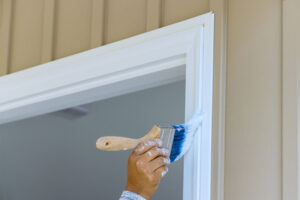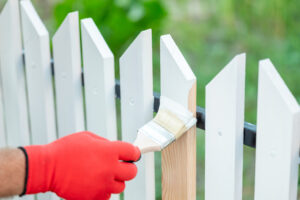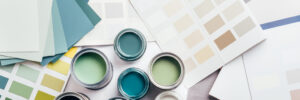
Best Paint for Trim and Baseboards
Baseboards and trim can elevate the appearance of your home’s interior, but even the most ornate trim piece will look dilapidated if it is not
So, you’ve just decided to revamp your home’s interior with a fresh, vibrant coat of paint. Unfortunately, you don’t have any experience painting a home’s interior. This type of painting project is entirely different from a furniture flip or exterior renovation. It will require an entirely different range of supplies, with different types of paint. Using the wrong type of materials can cause your paint to chip easily or prevent it from properly adhering to the walls. You definitely don’t want this to occur when you’ve spent a lot of time and money on your painting project.
So, if you’re planning on starting an interior painting project soon, you definitely need to have the right supplies to have a successful project and beautiful result. Luckily, this article will break down the must-have interior painting supplies for you, helping you to know everything you’ll need to transform your home into a gorgeous space. Remember, the better your painting supplies are, the better prepared you’ll be, and the better your painting results will end up!

If you have a fresh wall that is ready and prepped for painting, these are some of the basic supplies that you’ll need to get started. You may need different quantities or types of these supplies depending on the interior room that you’re working on. Additionally, if you have paint that you need to remove or damage that you need to repair, read on for some of the additional supplies below that can be used to repair those issues.
There are specific types of paint that will apply smoothly and evenly on an interior surface that shouldn’t be used for exterior jobs or furniture projects. You’ll also want to ensure that your interior paints have low VOC levels. This will help to prevent any unwanted and harmful chemicals from being released into the air in your home or absorbed into other interior materials. If you’re looking for vibrant, long-lasting paints with nonexistent VOC levels, try Vista Paint! They have many trendy paint colors that will work wonders for your home.
You’ll also need to get some primer. Primer helps your paint to go on smoothly, sticking to the wall successfully without any scratches, bubbles, or mars. It can also prevent future damage. There are even some types of paint that have a primer substance included in them.

Next, you’ll need to find some brushes. For most interior projects, you’ll need a paint edger brush and an angle brush. These brushes will help you to get the tight corners and hard-to-reach spaces that can be difficult to finish. Larger paint rollers or paint pads will be difficult to use in these small spaces, so brushes will come in handy.
If you only have brushes to work with, your painting project is going to take a long time. Using a paint roller or paint pads can help you apply the paint to large areas more quickly, effectively, and completely. This will also help you to get a more professional-looking finish to your paint.
Have you ever seen your paint dry out after you’ve let it sit out in the open for too long? Luckily, this issue can be remedied with a stirring stick or two. Use these inexpensive wooden sticks to stir your paint and keep it looking fresh.
If you don’t want to be dipping your brushes into your paint can, you should invest in a few paint trays. These trays are generally made of plastic or thin metal and are easy to clean and reuse. You can pour paint into your trays, allowing you to easily access the paint with your larger paint rollers or paint pads.
If you have any doors, windows, trim, or corners that you don’t want to cover with your new paint color, you’ll need some painter’s tape. This blue tape will help you to have clean lines without any bleeding paint.
If there are any cracks or holes in your drywall or wall surface, you’ll need to fill them before you add paint. You can easily do this by using some paint putty and a painting knife. Spackle and/or filler might also have a similar function.
You can protect furniture, flooring, and other materials from unwanted paint by covering them with a big canvas drop cloth.
If you have a high ceiling or wall that you can’t reach on your own, consider buying or renting a ladder to climb on or an extension pole for your paint rollers to make it easier.
If you’re trying to add a new coat of paint to a surface that already has an unwanted shade of paint, here are a few supplies you might need.

Paint scraping tools help you to remove old, unwanted coats of paint. You can also use these tools (or a wire brush) to remove rust or residue that disturbs the surface of your wall.
When you’re removing old paint, lots of dust, residue, and chemicals can be released into the air. You’ll want to wear safety equipment such as goggles and dust masks to prevent these materials from harming you.
If the old paint on your walls won’t allow you to get a smooth coat on top, you might need a sander to smooth out the surface. This will help you to remove the old colors and any outcropping residue.
Freshening up your surface with some cleaner before you add paint can also help you to get a cleaner, more professional-looking application.
If you need to seal up any cracks or fill any corners, caulk will be your best option. A caulking gun can make the caulk application very easy and quick.

Baseboards and trim can elevate the appearance of your home’s interior, but even the most ornate trim piece will look dilapidated if it is not

You’ve just installed your beautiful new fence! Now, while it cures, you have the difficult decision of choosing a stain or paint color. With all

How to Find the Right Color for Your Interior Paint Job Have you procrastinated painting the walls in your home because you’re worried you won’t

Baseboards and trim can elevate the appearance of your home’s interior, but even the most ornate trim piece will look dilapidated if it is not

You’ve just installed your beautiful new fence! Now, while it cures, you have the difficult decision of choosing a stain or paint color. With all